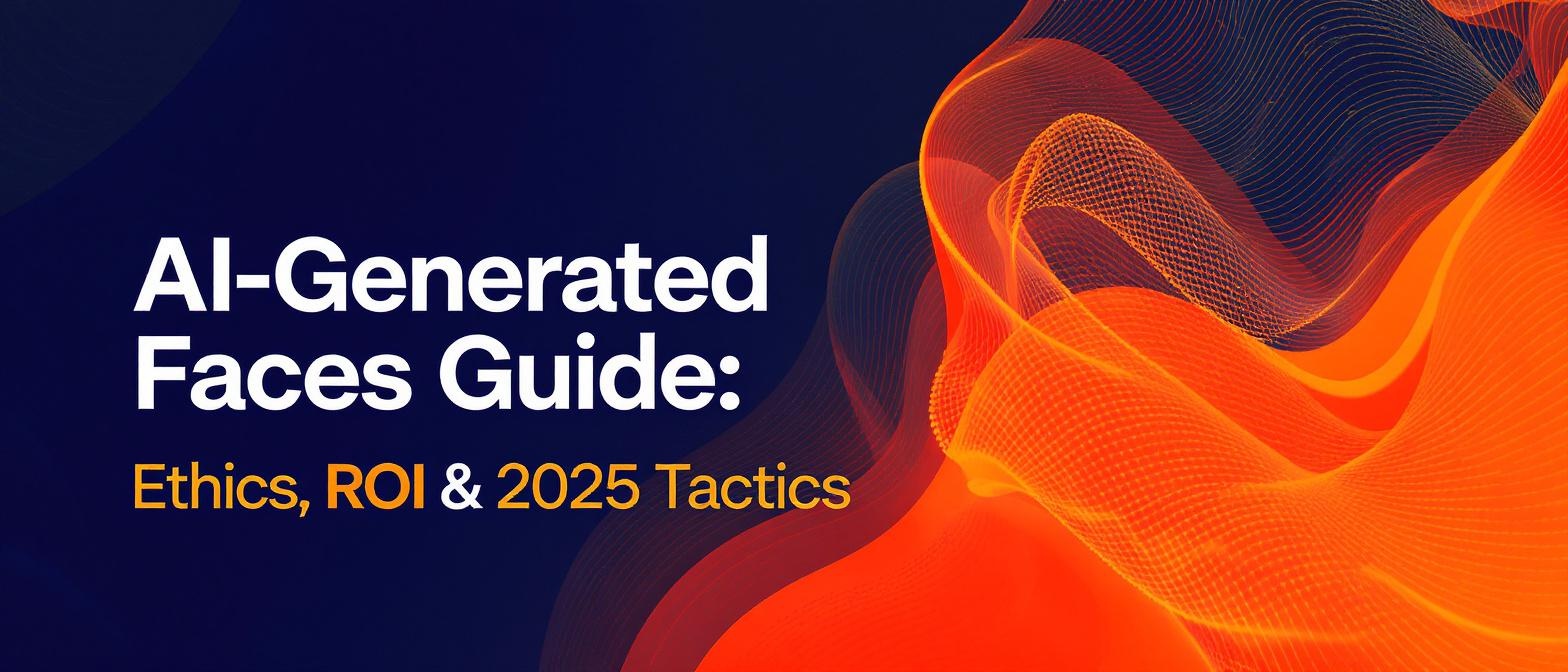Beyond the Uncanny Valley: A Guide to AI-Generated Faces in 2025
Estimated reading time: ~9 minutes
Key Takeaways
- AI-generated faces have evolved from novelty to critical business solutions.
- Ethical sourcing and licensed avatars are crucial to avoid legal and moral pitfalls.
- Practical frameworks accelerate ROI, including multilingual scaling and robust integrations.
- Transparency and governance help maintain trust as synthetic media becomes mainstream.
The rise of AI-generated faces is reshaping digital communication, with 96% of marketers agreeing that artificial intelligence will play a pivotal role in their strategies moving forward. While many articles explain the basics of technologies like Generative Adversarial Networks (GANs), they often stop short of addressing the critical implementation challenges and strategic frameworks businesses need to succeed. The conversation has moved beyond “what are AI faces?” to “how do we deploy them ethically, effectively, and with a measurable return on investment?” This guide tackles that gap head-on. We will explore the practical steps for integrating AI avatars into your workflows, navigate the complex ethical landscape of digital identity, and provide a clear framework for measuring the true ROI of this transformative technology. Prepare to move from theoretical understanding to strategic execution, ensuring your brand is a leader, not a laggard, in the age of synthetic media.
Section 1 – Reframing the Challenge: From Novelty to Necessity
The initial wave of AI-generated faces focused on their novelty, but deploying them at a strategic level requires confronting a new set of operational and ethical challenges. The primary hurdle isn’t just generating a realistic face; it’s ensuring that the entire content pipeline is scalable, secure, and aligned with brand values. A staggering 83% of engagement uplift is seen in AI-optimized content, but this is only achievable when the underlying data and governance are sound.
Many organizations struggle with inconsistent data formats and inadequate governance, which can lead to biased or inaccurate AI models. This is a critical risk, as biased outputs can damage brand reputation and alienate entire customer segments. Furthermore, as we build a world increasingly populated by digital personas, establishing trust is paramount. According to a comprehensive analysis of global trends in digital ethics by ScienceDirect, creating transparent and accountable systems is no longer optional. Businesses must move from merely using AI face generators as a tool to building a comprehensive strategy that includes robust data privacy protocols, clear ethical guidelines, and a commitment to transparently labeling synthetic media to maintain audience trust.
Section 2 – Innovation & Solutions: The Technology Driving a New Reality
While the competitor piece correctly identified GANs and diffusion models as the core technologies, a deeper understanding of the mechanics reveals why some solutions are better suited for enterprise use. The magic happens in what’s called the “latent space”—an abstract, high-dimensional space where the AI model learns to represent facial features. By manipulating vectors within this space, developers can control attributes like age, expression, and even ethnicity with incredible precision.
However, the true innovation lies not just in generation but in governance and usability. Early models were difficult to control and often produced uncanny or biased results. Modern systems address this with refined training datasets and sophisticated control mechanisms. Crucially, the source of these datasets is a major differentiator. Using publicly scraped images raises significant ethical and legal questions. In contrast, leading platforms use datasets built from fully licensed and consented footage of real actors. This “consent-first” model is the bedrock of ethical AI video creation. Platforms like Studio by TrueFan AI enable businesses to leverage this technology safely, providing access to libraries of pre-licensed, photorealistic avatars derived from real influencers. This approach bypasses the legal risks of unauthorized deepfakes and ensures the final output is built on an ethical foundation, complete with built-in content moderation to prevent misuse.
Section 3 – Advanced Implementation: A 5-Step Strategic Framework
Explaining the technology is one thing; implementing it for business growth is another. The competitor’s guide lacked a practical, step-by-step framework for integration. Here is a clear roadmap for moving from concept to campaign.
Step 1: Define the Strategic Use Case
Before generating a single image, define the goal. Is it to increase lead generation with personalized sales outreach? To cut training costs with multilingual e-learning modules? Or to boost social media engagement with rapid-response content? Your use case determines the avatar style, tone of voice, and integration points. For example, a B2B sales avatar needs a professional tone, while a social media influencer can be more casual.
Step 2: Scripting for a Synthetic Presenter
Writing for an AI avatar is different from writing for a human. Scripts should be concise, typically 100-120 characters per segment, to allow for natural pacing and pauses. Use clear, direct language. The beauty of AI is the ability to A/B test scripts rapidly. Write three variations of a call-to-action and generate videos for each to see which performs best.
Step 3: Generation and Localization at Scale
This is where modern platforms excel. Using a self-serve portal, upload your script, select your licensed avatar, and generate the initial video. The next step is scalable localization. With tools like Studio by TrueFan AI’s 175+ language support and AI avatars, you can convert a single English video into dozens of languages with perfectly synchronized lip movements in minutes, not months. This transforms a single asset into a global campaign.
Step 4: Integration into Existing Workflows
The most powerful applications of AI-generated faces involve automation. Use APIs and webhooks to connect your generation platform to your marketing automation or CRM systems. For instance, you can create a workflow where a new lead in your CRM automatically triggers the generation of a personalized welcome video from your AI sales avatar, delivered via email or WhatsApp.
Step 5: Review, Moderate, and Deploy
Always review generated content against your brand guidelines. Modern platforms have built-in moderation to block profanity, hate speech, and other harmful content. Once approved, deploy the content across your chosen channels—social media, website, email campaigns, or internal training portals—and begin tracking performance metrics.
Section 4 – Overlooked Considerations: The Creator Economy and Brand Authenticity
A significant sub-topic ignored by the competitor is the impact of AI-generated faces on the creator economy. This technology is not just for large corporations. Individual creators, YouTubers, and consultants are now using AI co-presenters and digital twins to scale their content production. An educator can create an entire course presented by their AI avatar, translated into ten languages, while they focus on developing the next curriculum. This democratizes content creation, allowing solopreneurs to compete with large media houses.
This trend, however, introduces a contrarian challenge: maintaining authenticity. As audiences become more aware of synthetic media, they will place a higher premium on genuine connection. The key is not to replace the human but to augment them. Successful brands will use AI avatars for scalable communication (like personalized onboarding videos or product explainers) while reserving their human experts for high-touch interactions (like live Q&A sessions or strategic consulting). The goal is a “centaur” model, where human creativity guides AI’s execution. For guidance on navigating these new digital identity paradigms, organizations like IDPro offer valuable frameworks for ethical practice.
Section 5 – ROI & Metrics: Calculating the True Value of AI Avatars
The competitor vaguely mentioned cost savings, but a robust business case requires concrete ROI metrics. The value of AI-generated faces extends far beyond reducing production budgets. A 2024 McKinsey report found that companies leveraging AI in marketing see a 20-30% higher return on investment in their campaigns.
Here’s a simple framework to calculate your potential ROI:
-
Calculate Cost Savings (The Baseline):
- Traditional Video: (Actor Fees + Studio Rental + Crew Hire + Travel Costs + Post-Production) x Number of Videos = Total Traditional Cost.
- AI Video: (Platform Subscription Fee + Staff Time) = Total AI Cost.
- Savings = Total Traditional Cost - Total AI Cost.
-
Measure Performance Lift (The Growth Multiplier):
- Conversion Rate: Track the conversion rate of AI-driven video ads or landing pages versus static images or text. An increase of even 0.5% at scale can translate to significant revenue.
- Engagement Metrics: Monitor watch time, click-through rates, and shares. Higher engagement often correlates with increased brand recall and loyalty.
- Sales Cycle Velocity: For sales use cases, measure the time from first touch to closed deal. Personalized AI videos can shorten this cycle by delivering the right information at the right time.
Solutions like Studio by TrueFan AI demonstrate ROI through radical efficiency gains in localization and personalization, allowing a single marketing asset to be adapted for dozens of global markets in a single afternoon. This “content velocity” is a key competitive advantage that traditional production models cannot match.
Section 6 – Future Roadmap: Preparing for the 2025 Landscape
The technology of AI-generated faces is not standing still. As we look toward 2025 and beyond, several emerging trends will define the next wave of innovation. Preparing for them now is essential for maintaining a competitive edge.
First, the rise of real-time interaction will transform AI avatars from pre-recorded presenters into interactive agents. Imagine a customer service avatar on your website that can have a spoken conversation, answer complex questions, and guide users through a process. This will merge large language models (LLMs) with real-time video generation.
Second, hyper-realism and cross-modal generation will continue to advance. Expect 8K resolution to become standard and for models to generate a complete, dynamic video scene from a single photo or text prompt.
To prepare, businesses should focus on building “AI-ready” teams. This involves upskilling staff in areas like prompt engineering, AI ethics, and data management. Fostering a culture of experimentation will be key. Start with small, low-risk projects to learn the capabilities and limitations of the technology before scaling up to mission-critical applications. The future belongs to the “Content Creation Centaurs”—professionals who seamlessly blend human strategy with AI execution.
Frequently Asked Questions
1. How do you ensure AI-generated faces don’t perpetuate biases?
This is a critical concern. The key is threefold: using diverse and ethically sourced training data, providing user controls to define avatar characteristics like ethnicity and age, and conducting regular audits of the AI models to identify and correct for any emergent biases. It requires a proactive, rather than reactive, approach to fairness.
2. What is the legal difference between a “deepfake” and a licensed AI avatar?
The difference lies in consent and licensing. A “deepfake” typically uses a person’s likeness without their permission, which can be illegal and unethical. A licensed AI avatar is created from a real actor who has explicitly consented and been compensated for the use of their digital likeness, ensuring the entire process is legally and ethically sound.
3. How can we maintain brand consistency when using AI avatars?
Brand consistency is maintained through strict governance. This involves creating detailed guidelines for your AI avatars, including their tone of voice, the topics they can discuss, and their visual presentation. Platforms like Studio by TrueFan AI offer features like custom avatars and walled-garden environments to ensure all generated content aligns perfectly with your brand’s identity.
4. What are the biggest technical hurdles to implementing AI video generation?
The biggest hurdles are typically integration and data management. Connecting an AI generation platform to existing systems like a CRM or marketing automation tool requires technical expertise (APIs, webhooks). Ensuring you have clean, well-structured data to personalize videos at scale is another significant challenge that requires upfront planning.
5. How does the technology handle different languages and accents?
Advanced AI models are trained on vast multilingual datasets. When you input a script in a specific language, the model generates not only the correct words but also the corresponding lip movements and inflections. The best platforms can distinguish between regional accents, allowing for highly authentic localization that truly resonates with a local audience.
6. What measures are in place to prevent the misuse of this technology?
Reputable platforms employ robust safety filters and moderation policies. This includes real-time scanning of scripts to block prohibited content (e.g., hate speech, political propaganda, explicit material) and watermarking outputs for traceability. This commitment to safety is crucial for protecting both the platform and its users. For more on this, TechUK provides insights into value-led AI approaches.
Conclusion
The era of AI-generated faces has officially moved from experimental curiosity to a strategic business imperative. While the underlying technology of GANs and diffusion models is fascinating, the true competitive advantage comes from a deep understanding of implementation, ethics, and ROI. The winning strategy in 2025 is not simply to use AI avatars but to integrate them into a thoughtful, human-centric workflow that prioritizes consent, mitigates bias, and delivers measurable value. By adopting a practical framework, focusing on licensed and ethical content sources, and preparing for the next wave of real-time interaction, your organization can harness this technology to create more personalized, accessible, and impactful communications than ever before. The future doesn’t belong to the machines; it belongs to those who can artfully wield them to enhance human connection.




